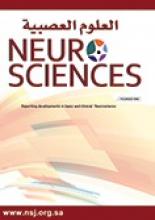Abstract
OBJECTIVE: To report the clinical and imaging findings in patients living in the Western Province of the Kingdom of Saudi Arabia where the Benin b-globin gene haplotype is prevalent.
METHODS: Our study population consists of 36 sickle cell disease patients (17 males, 19 females; age range, 1.6-35.6 years; mean age, 19.4 years) with suspected cerebrovascular complications. Major clinical presentations were as follows: stroke symptoms or history of stroke in 13 (36%) patients, severe headache in 16 (44.4%), and seizures in 9 (25%). All patients underwent brain CT, or MRI study, or both, including diffusion imaging and magnetic resonance angiography. We conducted the study between August 2001 and June 2004 at King Abdul-Aziz University Hospital, Jeddah, Kingdom of Saudi Arabia.
RESULTS: Based on MRI, or CT, or both, we found cortical infarction in 30.6% (11/36) of patients. The frontoparietal temporal region was the most commonly involved part and occurred in 4 patients. We diagnosed small vessel disease in 38.9% (14/36) of patients, and involvement was bilateral in 9 patients. Small vessel disease involved deep white mater more than basal ganglia, and the caudate nucleus was the most commonly involved site in basal ganglia. We detected cerebral atrophy in 52.8% (19/36) of patients. An unusual finding was an epidural hematoma associated with skull bone infarctions and scalp edema that we successfully managed conservatively. We observed a widening of the diploic space of the skull in 10 patients. We saw adenoid hypertrophy in a significant number of patients (72% [26 of 36]).
CONCLUSION: Sickle cell disease cerebrovascular complications are of major concern to the physician. Cerebral atrophy is the most common imaging finding followed by small vessel disease and then by cortical infarction. There was an increased incidence of adenoid hypertrophy.
- Copyright: © Neurosciences
Neurosciences is an Open Access journal and articles published are distributed under the terms of the Creative Commons Attribution-NonCommercial License (CC BY-NC). Readers may copy, distribute, and display the work for non-commercial purposes with the proper citation of the original work.






